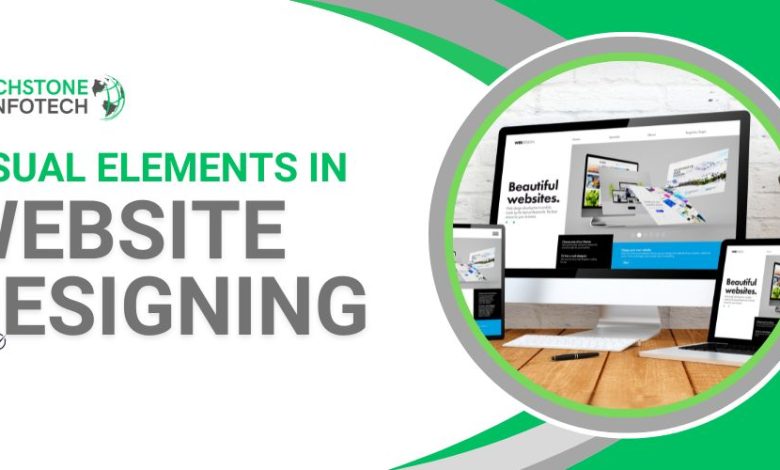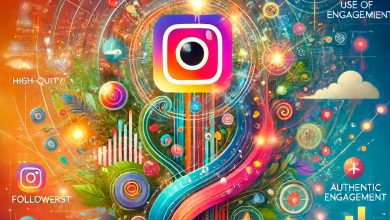Visual Elements in Website Designing: Typography, Color, and Imagery
Visual Elements in Website Designing

In the digital realm, a website’s visual appeal is its first impression. The intricate blend of typography, color, and imagery contributes to a website’s identity, usability, and overall user experience. In this blog, we’ll delve into these essential visual elements and explore how they shape the art of website designing.
Typography: The Art of Words
Typography is more than just selecting a font; it’s about conveying your brand’s personality through the arrangement of letters. The choice of typeface, font size, spacing, and alignment plays a pivotal role in readability and aesthetics. Whether it’s a crisp sans-serif font for a modern vibe or a classic serif font for a timeless touch, typography sets the tone for your website’s content.
But it’s not just about choosing the right font; it’s also about maintaining consistency across various devices and screen sizes. Responsive typography ensures that your message is as captivating on a smartphone as it is on a desktop.
Color: The Palette of Emotions
Colors hold immense power in evoking emotions and conveying messages. Each color has its psychological impact, and the color scheme you choose should align with your brand identity and purpose. Vibrant hues can exude energy, while muted tones create a sense of sophistication. A harmonious color palette enhances user engagement and guides visitors’ attention to key elements.
But the true art lies in balance. Using a judicious mix of primary, secondary, and accent colors ensures that your website is visually pleasing without overwhelming the visitor. It’s a dance of shades that guides users seamlessly through your content.
Imagery: The Visual Storyteller
Imagery speaks where words fall short. High-quality images, graphics, and videos bring life to your website, giving visitors a glimpse into your world. Whether it’s showcasing products, sharing your team’s story, or illustrating your brand’s journey, imagery creates a connection that words alone cannot achieve.
But relevance is key. Every image should serve a purpose and align with your content. Optimizing images for fast loading speeds ensures that your website remains user-friendly and responsive.
Website Designing Importance for E-commerce
Layout and Grids: Structured Harmony
The layout of a website is like the blueprint of a building – it guides visitors on how to navigate and interact with the content. An organized layout ensures a seamless user experience and helps in conveying information in a clear and coherent manner. Grid systems, for instance, provide a structured framework for arranging elements such as text, images, and buttons. A well-implemented grid not only aids in maintaining consistency but also makes the content visually pleasing. Whether it’s a minimalist design with ample whitespace or a dynamic asymmetrical layout, the choice of layout can greatly influence the overall aesthetic and usability of the website.
Grid systems can be tailored to suit the website’s identity, be it a symmetrical grid for a formal corporate site or an asymmetrical grid for a creative portfolio. The New York Times website employs a sophisticated grid layout to present diverse content categories in an organized manner, showcasing the adaptability and efficiency of this visual element.
Icons and Illustrations: Visual Simplification
Icons and illustrations are like the universal language of the internet. They communicate complex ideas in a compact and easily understandable manner. Icons are concise visual representations of concepts, actions, or objects, serving as intuitive navigation aids. Meanwhile, illustrations inject personality into a website and can narrate stories that resonate with the audience. When used cohesively with the overall design, icons and illustrations can create a friendly and approachable atmosphere, making the website more engaging and relatable.
When icons are designed with care and precision, they can simplify complex processes and reduce the cognitive load on users. The envelope icon for email, the magnifying glass for search, and the hamburger icon for menus have become ingrained in our collective digital vocabulary. Airbnb’s website effectively employs icons to guide users through the booking process, showcasing the power of this visual language.
Whitespace: The Breathing Space
Whitespace, often referred to as negative space, is the area between and around elements on a web page. It might seem counterintuitive, but whitespace is a powerful design tool. It allows content to breathe, guiding the user’s focus and preventing visual clutter. Whitespace can evoke a sense of elegance, simplicity, and sophistication. When strategically employed, it enhances readability, improves comprehension, and gives the design a balanced and uncluttered appearance.
Websites that embrace whitespace make the user’s journey intuitive and delightful. The balance between content and whitespace creates a harmonious composition that invites exploration. Google’s minimalist search interface is a prime example of how the thoughtful integration of whitespace can result in an uncluttered and engaging user experience.
Carefully positioned lines and dividers foster a visual hierarchy that helps users prioritize content and understand relationships between different elements. The BBC News website employs lines to separate news stories, showcasing the importance of visual organization in content-rich websites.
Animations and Micro interactions: Dynamic Engagement
Incorporating animations and micro interactions into web design can infuse vitality and interactivity. Animations, such as subtle hover effects or smooth transitions, provide a sense of fluidity and guide the user’s attention. Micro interactions, on the other hand, are those tiny, often unnoticed responses to user actions – think of the heart icon animation when you “like” a post on social media. These micro interactions may seem minor, but they contribute significantly to the overall user experience by making interactions more enjoyable and engaging.
Animations can be used to reveal content gradually, enhancing the user’s sense of discovery. Smooth transitions between pages create a seamless browsing experience. Apple’s website is a masterclass in utilizing animations to showcase products and features, showcasing how motion can elevate a website’s visual appeal.
Lines and Dividers: The Visual Hierarchy
Lines and dividers are often used in web design to create visual hierarchy and separate content into sections. Horizontal lines can guide users through a page, while vertical dividers can delineate content areas or columns. These visual elements help structure information, making it easier for users to digest and navigate a website. Well-placed lines and dividers can also add a touch of sophistication to the design.
While typography, color, and imagery are the stars of website design, other visual elements play supporting roles in creating an exceptional user experience. Whitespace, grid systems, icons, lines, textures, patterns, animations, and transitions all contribute to a website’s visual appeal, usability, and overall impact.
Textures and Patterns: Adding Depth and Character
Textures and patterns evoke a tactile experience in the digital realm. They add depth and dimension to a website, imbuing it with character and personality. While often subtle, textures can simulate real-world surfaces, creating an emotional connection with users.
Patterns, on the other hand, add visual interest and uniqueness to a design. When used judiciously, they can enhance a website’s aesthetic appeal and reinforce its branding. The website of a luxury spa, for instance, might incorporate soft, organic textures to convey a sense of tranquility and relaxation.
In the vast landscape of web design, certain visual elements command attention due to their inherent significance. However, the unsung heroes of design, such as whitespace, grid systems, icons, lines, textures, patterns, animations, and transitions, play a crucial role in shaping user experiences. These elements work harmoniously to improve readability, organization, engagement, and aesthetics, ultimately defining the essence of a website.
As designers continue to push the boundaries of creativity, it’s essential to recognize and embrace the potential of these often-overlooked visual elements. By integrating them thoughtfully, web designers can create digital experiences that resonate with users on multiple levels, elevating the impact and effectiveness of their designs.
Crafting a Seamless Experience with Touchstone Infotech
Are you ready to transform your online presence? At Touchstone Infotech, a leading Website Designing Company in Delhi, we specialize in creating captivating websites that leverage the power of visual elements. Our creative team understands the intricate nuances of typography, color, and imagery to craft websites that not only look stunning but also deliver exceptional user experiences.
Whether you’re launching a new venture or revamping an existing website, our expertise ensures that your online business stands out in the digital landscape. With attention to detail and a passion for innovation, we design websites that make an impact.
Ready to Elevate Your Online Presence? Contact Touchstone Infotech Today!
Contact us to design a website that resonates with your audience, tells your brand story, and drives success in the digital world. Your online journey begins with Touchstone Infotech.
Remember, a visually appealing website isn’t just a luxury; it’s a necessity in today’s digital age. Let’s turn your vision into a captivating reality!






